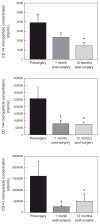Restoration of glycemic control in patients with type 2 diabetes mellitus after bariatric surgery is associated with reduction in microparticles
- PMID: 22093380
- PMCID: PMC3311701
- DOI: 10.1016/j.soard.2011.09.026
Restoration of glycemic control in patients with type 2 diabetes mellitus after bariatric surgery is associated with reduction in microparticles
Abstract
Background: Microparticles bud from cellular elements during inflammation and are associated with the vascular dysfunction related to type 2 diabetes mellitus. Although weight loss is known to reduce inflammation, the metabolic effects of bariatric surgery on microparticle concentration and composition are not known. Our objectives were to determine the effect of bariatric surgery on the microparticle concentration and to correlate these changes with clinical parameters in a multispecialty group practice.
Methods: We studied 14 obese subjects with type 2 diabetes mellitus 2 weeks before and 1 and 12 months after bariatric surgery. Of the 14 patients, 9 underwent Roux-en-Y gastric bypass and 5 gastric restrictive surgery.
Results: At 1 month after surgery, the body mass index had decreased by ∼10%, glycemic control had improved dramatically (P < .01), and a >60% reduction in endothelial and platelet microparticles and C-reactive protein levels (P < .05) had occurred. The tissue factor microparticles had decreased by 40% (P = .1). At 12 months after surgery, the body mass index had decreased by ∼20%, glycemic control was maintained (P < .01), and a >50% reduction in monocyte microparticles compared with before surgery was found. The reduction in monocyte microparticles 1 month after surgery was strongly associated with the reduction in hemoglobin A1c (P < .05). The reduction in monocyte microparticles 12 months after surgery correlated strongly with the reduction in body mass index (P < .05).
Conclusion: The reduction in microparticles after bariatric surgery in patients with type 2 diabetes mellitus reflects an attenuation of inflammation, and this mechanism might contribute to normalization of glycemic control.
Copyright © 2013 American Society for Metabolic and Bariatric Surgery. Published by Elsevier Inc. All rights reserved.
Figures



References
-
- Sabatier F, Darmon P, Hugel B, et al. Type 1 and type 2 diabetic patients display different patterns of cellular microparticles. Diabetes. 2002;51:2840–5. - PubMed
-
- Koga H, Sugiyama S, Kugiyama K, et al. Elevated levels of VE-cadherin-positive endothelial microparticles in patients with type 2 diabetes mellitus and coronary artery disease. J Am Coll Cardiol. 2005;45:1622–30. - PubMed
-
- Koga H, Sugiyama S, Kugiyama K, et al. Elevated levels of remnant lipoproteins are associated with plasma platelet microparticles in patients with type-2 diabetes mellitus without obstructive coronary artery disease. Eur Heart J. 2006;27:817–23. - PubMed
-
- Ogata N, Imaizumi M, Nomura S, et al. Increased levels of platelet-derived microparticles in patients with diabetic retinopathy. Diabetes Res Clin Pract. 2005;68:193–201. - PubMed
-
- Omoto S, Nomura S, Shouzu A, Nishikawa M, Fukuhara S, Iwasaka T. Detection of monocyte-derived microparticles in patients with type II diabetes mellitus. Diabetologia. 2002;45:550–5. - PubMed
Publication types
MeSH terms
Substances
Grants and funding
LinkOut - more resources
Full Text Sources
Other Literature Sources
Medical
Research Materials

